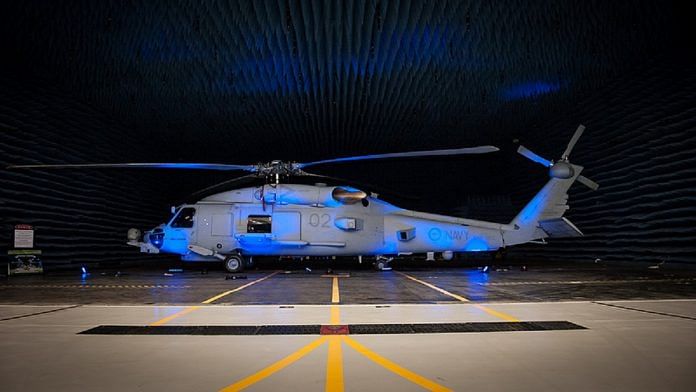New Delhi: The US State Department has approved the sale of 24 MH-60R multi-mission helicopters to India, providing a boost to the Indian Navy’s dwindling anti-submarine warfare strength.
Cleared under the State Department’s Foreign Military Sales (FMS) programme, the sale will cost India $2.6 billion. It comes 19 years after the Navy moved a proposal to acquire medium multi-role helicopters.
The 24 MH-60R — ‘R’ stands for ‘Romeo’ — multi-mission helicopters, known as ‘Seahawks’, are manufactured by Lockheed Martin. The Navy is hopeful that the first of these will be delivered this year.
Also read: Indian Navy to get 56 new warships in next 10 years, including third aircraft carrier
What are ‘Romeo’ helicopters?
The Seahawks will replace the de-commissioned Seaking Mk 42 ASW [anti-submarine warfare] and Seaking 42 A.
The Indian Navy, which is a 140-warship force, currently operates a dozen Seaking 42 B, called ‘Flying Frigates’, and 10 Kamov-28 anti-submarine warfare choppers.
A separate process to replace Seaking 42 B with 123 new naval multi-role helicopters, under a strategic partnership with production in India, is currently underway.
Romeo: Naval version of the Black Hawk
The MH-60 ‘Romeo’ helicopters, known as submarine hunters, are advanced naval machines equipped with sophisticated combat systems — sensors, missiles and torpedoes — to track and hunt enemy boats.
The ‘Romeos’ are extensively deployed with the US Navy as its primary anti-submarine warfare and anti-surface weapons system.
For the Indian Navy, the choppers are set to employ Hellfire air-to-surface missiles and Mark 54 anti-submarine torpedoes.
The twin-turboshaft-engine helicopter is a naval version of the famous Black Hawks of US manufacturer Sikorsky Aircraft — the choppers movie aficionados would recall from the 2002 Ridley Scott hit, Black Hawk Down, on the Battle of Mogadishu.
The most significant modifications in Romeos are the folding main rotor and a hinged tail to reduce its footprint aboard ships.
Apart from the US Navy, the Seahawks are used by the Royal Danish Navy, Royal Australian Navy, and Royal Saudi Naval Forces.
Equipped for deployment aboard any air-capable frigate, destroyer, aircraft carrier, combat support ship and corvette, among others, the Seahawk can carry out anti-submarine warfare, anti-surface warfare, search and rescue, combat search and rescue, and naval special warfare insertion, among other things.
With over 300 MH-60R Seahawks worldwide, the helicopters have clocked over 600,000 flying hours altogether.
The cabin of the helicopter can accommodate three or four flight crew members and five passengers. The length of the cabin is 3.2 metres, while the height and width are 1.3 metres and 1.8 metres, respectively.
For anti-surface warfare missions, the helicopter can be equipped with a range of weapons on the four weapon stations.
The MH-60R can carry up to three ATK mk50 or mk46 active/passive lightweight torpedoes for anti-submarine warfare, and a pintle-mounted 7.62-mm machine gun can also be fitted for self-defence.
Why Navy needs it
The acquisition of new multi-role helicopters has been pending for over a decade. The Navy had identified the helicopters as well as minesweepers and submarines as the top three “critical operational necessities” during the term of former defence minister Manohar Parrikar, who had called for a review of all pending acquisition projects.
“With changing dynamics in the region and the big focus on anti-submarine warfare, the new choppers will add to the lethal power of the Indian Navy,” a senior Naval officer told ThePrint.
One of the main concerns for the Indian Navy is the submarine forays by China into waters around India and Pakistan’s reliance on submarines rather than surface ships.
Pakistan, which has five conventional submarines, is looking to buy six more from China.
India will use the enhanced capability achieved through the helicopters, considered to be the most modern in the world, as a deterrent to regional threats as well as to strengthen homeland defence, the State Department said in a notification to the US Congress. It added that India will have no difficulty absorbing these helicopters into its armed forces.
The proposed sale of this equipment and support will not alter the basic military balance in the region, the State Department said.
Also read: Indian Navy & IAF chiefs get Z-plus security cover amid India-Pakistan tensions







Your newspaper, like almost all the Indian press, when material acquisitions are made, neglects an important point: the financing of acquisitions by the defense budget of the country. Here, it is said that the proposal for the acquisition of these helicopters was made by the Navy, 19 years ago. Logically, the question that should come to mind is how will the financing of the purchase of these helicopters be secured? This is a question that arises with every announcement of purchase of material. Moreover, in this case, when the proposal has been definitively validated in the United States, the Indian Government will have to decide on the financing of this acquisition. You will recognize that over the last few years many announcements have been made, but without specifying the financial means. This opacity can only undermine the credibility of the expenditures allocated each year to the country’s defense budget and in particular to its component dealing with equipment expenditures.